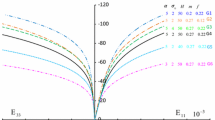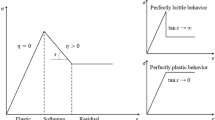Abstract
A unified elastoplastic model for describing the stress–strain behavior of partially saturated collapsible rocks is proposed. The elastic–plastic response due to loading and unloading is captured using bounding surface plasticity. The coupling effect of hydraulic and mechanical responses is addressed by applying the effective stress concept. Special attention is paid to the rock–fluid characteristic curve (RFCC), effective stress parameter, and suction hardening. A wide range of saturation degree is considered. The characteristics of mechanical behavior in partially saturated collapsible rocks are captured for all cases considered.









Similar content being viewed by others
Abbreviations
- \(A\) :
-
Sign for loading direction
- \(F\) :
-
Bounding surface
- \(f\) :
-
Loading surface
- \(G^{\text{e}}\) :
-
Elastic shear modulus
- \(g\) :
-
Plastic potential
- \(h\) :
-
Hardening modulus
- \(h_{\text{b}}\) :
-
Hardening modulus at bounding surface
- \(h_{\text{f}}\) :
-
Additive hardening modulus
- \(J_{2}\) :
-
Second invariant of deviatoric stress
- \(K_{\text{bulk}}^{\text{e}}\) :
-
Elastic bulk modulus
- \(k_{\text{m}}\) :
-
Material parameter
- \(M\) :
-
Total mass of porous rock
- \(M_{\alpha }\) :
-
Mass of phase \(\alpha\) (\(\alpha = \text{s},\;\text{w},\;\text{a}\) represents solids, water, and air, respectively)
- \(M_{\text{cs}}\) :
-
Slope of critical state line (CSL)
- \(M_{\text{cs}}^{ - }\) :
-
Slope of CSL for triaxial extension
- \(M_{\text{cs}}^{ + }\) :
-
Slope of CSL for triaxial compression
- \(m_{p}\) :
-
Component of unit direction along the mean effective stress axis
- \(N\) :
-
Parameter controlling shape of bounding surface
- \(N\left( s \right)\) :
-
Specific volume on isotropic compression line at mean effective stress of 1 kPa or 1 MPa
- \(p^{\prime}\) :
-
Mean effective stress
- \(p^{\prime}_{\text{c}}\) :
-
Size of loading surface
- \(p^{\prime}_{\text{co}}\) :
-
Maximum pressure experienced in the past
- \(p^{\prime}_{\text{cs}}\) :
-
Mean effective stress at critical state
- \(p^{\prime}_{0}\) :
-
Size of plastic potential
- \(\bar{p^{\prime}}\) :
-
Mean effective stress on bounding surface
- \(\bar{p^{\prime}}_{\text{c}}\) :
-
Size of bounding surface
- \(\bar{p^{\prime}}_{\text{ci}}\) :
-
Initial value of hardening parameter
- \(\bar{p^{\prime}}_{\text{cf}}\) :
-
Final value of hardening parameter
- \(P_{\text{a}}\) :
-
Air pressure
- \(\dot{P}_{\text{a}}\) :
-
Increment of air pressure
- \(P_{\text{w}}\) :
-
Water pressure
- \(\dot{P}_{\text{w}}\) :
-
Increment of water pressure
- \(q\) :
-
Deviatoric stress
- \(\bar{q}\) :
-
Deviatoric stress at bounding surface
- \(R\) :
-
Material parameter in bounding surface
- s :
-
Suction
- \(\dot{s}\) :
-
Increment of suction
- S i :
-
Initial suction value
- \(s_{\text{ae}}\) :
-
Air entry value
- \(s_{\text{e}}\) :
-
Suction value at saturation state changing point
- \(s_{\text{ex}}\) :
-
Air expulsion value
- \(s_{\text{rd}}\) :
-
Suction reversal point on drying path
- \(s_{\text{rw}}\) :
-
Suction reversal point on wetting path
- \(S_{\text{eff}}\) :
-
Effective degree of saturation
- \(S_{\text{r}}\) :
-
Degree of saturation
- \(S_{\text{re}}\) :
-
Residual degree of saturation
- \(t\) :
-
Sign for loading direction
- \(V\) :
-
Total volume of partially saturated rock
- \(V_{\alpha }\) :
-
Volume of phase \(\alpha\) (\(\alpha = \text{s},\;\text{w},\;\text{a}\))
- \(\alpha\) :
-
Material number (\(\alpha = \text{s},\;\text{w},\;\text{a}\))
- \(\chi\) :
-
Effective stress parameter
- \(\varepsilon_{q}\) :
-
Deviatoric strain
- \(\varepsilon_{p}\) :
-
Volumetric strain
- \(\varepsilon_{p}^{\text{p}}\) :
-
Plastic volumetric strain
- \(\dot{\varepsilon }_{p}^{\text{p}}\) :
-
Plastic volumetric strain rate
- \(\Delta \varepsilon_{p}^{\text{p}}\) :
-
Plastic volumetric strain increment
- \(\varphi^{\prime}\) :
-
Drained friction angle
- \(\varGamma \left( s \right)\) :
-
Specific volume on critical state line at mean effective stress of 1 kPa or 1 MPa
- \(\gamma \left( s \right)\) :
-
Suction hardening function
- \(\eta\) :
-
Stress ratio
- \(\eta_{\text{p}}\) :
-
Slope of peak strength line in \(p^{\prime}-q\) plane
- \(\kappa\) :
-
Slope of elastic unloading–reloading line in \(\upsilon-\ln p^{\prime}\) plane
- \(\lambda \left( s \right)\) :
-
Slope of isotropic compression line in \(\upsilon-\ln p^{\prime}\) plane
- \(\lambda_{\text{p}}\) :
-
Index for pore size distribution
- \(v\) :
-
Poisson ratio
- \(\theta\) :
-
Lode angle
- \(\upsilon\) :
-
Specific volume
- \(\upsilon_{\text{cs}}\) :
-
Specific volume at critical state line
- \(\upsilon_{\text{i}}\) :
-
Initial value of a specific state
- \(\upsilon_{\text{IC}}\) :
-
Specific volume at isotropic compression line
- \(\zeta\) :
-
Slope of drying–wetting transition line in \(\ln S_{\text{r}}-\ln s\) plane
- \(\varsigma\) :
-
Slope of drying–wetting transition line in \(\ln \chi -\ln s\) plane
- \(\psi\) :
-
Incremental effective stress parameter
- \(\varOmega\) :
-
Material parameter
- \(\varvec{D}^{\text{e}}\) :
-
Elastic stiffness
- \(\varvec{m}\) :
-
Unit direction of plastic flow
- \(\varvec{n}\) :
-
Unit vector normal to loading/bounding surface
- \(\varvec{\delta}\) :
-
Identity vector
- \(\varvec{\varepsilon}\) :
-
Strain vector
- \(\dot{\varvec{\varepsilon }}\) :
-
Incremental form of strain
- \(\dot{\varvec{\varepsilon }}^{\text{e}}\) :
-
Incremental form of elastic strain
- \(\dot{\varvec{\varepsilon }}^{\text{p}}\) :
-
Incremental form of plastic strain
- \(\varvec{\varepsilon}^{\text{dev}}\) :
-
Deviatoric strain vector
- \(\varvec{S}\) :
-
Deviatoric stress vector
- \(\varvec{\sigma}\) :
-
Total stress vector
- \(\varvec{\sigma^{\prime}}\) :
-
Effective stress vector
- \(\bar{\varvec{\sigma }^{\prime} }\) :
-
Effective stress on bounding surface
- \(\dot{\varvec{\sigma }^{\prime} }\) :
-
Incremental form of effective stress
- \(\varvec{\sigma}_{\text{net}}\) :
-
Net stress vector
- \(\dot{\varvec{\sigma }}_{\text{net}}\) :
-
Incremental form of net stress
References
Alonso EE, Gens A, Josa A (1990) A constitutive model for partially saturated soils. Geotechnique 40:405–430
Bell FG, Cripps JC, Edmunds CN, Culshaw MG (1990) Chalk fabric and its relation to certain geotechnical properties. In: Proceeding of the International Chalk Symposium London Thomas Telford
Bishop AW (1959) The principle of effective stress. Teknisk Ukeblad 106:859–863
Bishop AW, Blight GE (1963) Some aspects of effective stress in saturated and partly saturated soils. Geotechnique 13:177–197
Bishop AW, Donald IB (1951) The experimental study of partly saturated soil in triaxial apparatus. In: Proceedings of the 5th International Conference on SMFE. Dunod, Paris
Brignoli M, Sartori L (1993) Incremental constitutive relations for the study of wellbore failure. Int J Rock Mech Min Sci Geomech Abstr 30:1319–1322
Brignoli M, Santarelli FJ, Righetti C (1994) Capillary phenomena in an impure chalk. In: Proceedings of the Eurock ‘94. Delft
Brooks RH, Corey AT (1964) Hydraulic properties of porous media, Fort Collins, CO, Colorado State University
Collin F, Cui YJ, Schroeder C, Charlier R (2002) Mechanical behaviour of lixhe chalk partly saturated by oil and water: experiment and modelling. Int J Numer Anal Methods Geomech 26:897–924
Dafalias YF, Herrmann LR, (1980) A bounding surface soil plasticity model. Soils under cyclic and transient loading, volume 1 Proc International Symposium, Swansea 7–11 Jan 1980. pp 335–345
Duperret A, Taibi S, Mortimore RN, Daigneault M (2005) Effect of groundwater and sea weathering cycles on the strength of chalk rock from unstable coastal cliffs of NW France. Eng Geol 78:321–343
Fleureau J-M, Kheirbek-Saoud S, Soemitro R, Taibi S (1993) Behavior of clayey soils on drying–wetting paths. Can Geotech J 30:287–296
Guo PJ, Wan RG (1998) Modelling the cyclic behaviour of brittle materials using a bounding surface plasticity-damage model. Int J Rock Mech Min Sci 35:437–438
Hassanizadeh SM, Gray WG (1990) Mechanics and thermodynamics of multiphase flow in porous media including interphase boundaries. Adv Water Resour 13:169–186
Homand S, Shao JF (2000) Mechanical behaviour of a porous chalk and water/chalk interaction. Part ii: Numerical modelling. Oil Gas Sci Technol Rev IFP 55:599–609
Houlsby GT (1997) The work input to an unsaturated granular material. Geotechnique 47:193–196
Hoxha D, Giraud A, Homand F, Auvray C (2007) Saturated and unsaturated behaviour modelling of Meuse–Haute/Marne argillite. Int J Plasticity 23:733–766
Jia Y, Bian HB, Su K, Kondo D, Shao JF (2010) Elastoplastic damage modeling of desaturation and resaturation in argillites. Int J Numer Anal Methods Geomech 34:187–220
Khalili N, Khabbaz MH (1998) A unique relationship for chi for the determination of the shear strength of unsaturated soils. Geotechnique 48:681–687
Khalili N, Zargarbashi S (2010) Influence of hydraulic hysteresis on effective stress in unsaturated soils. Geotechnique 60:729–734
Khalili N, Geiser F, Blight GE (2004) Effective stress in unsaturated soils: review with new evidence. Int J Geomech 4:115–126
Khalili N, Habte MA, Valliappan S (2005) A bounding surface plasticity model for cyclic loading of granular soils. Int J Numer Anal Methods Eng 63:1939–1960
Khalili N, Habte MA, Zargarbashi S (2008) A fully coupled flow deformation model for cyclic analysis of unsaturated soils including hydraulic and mechanical hystereses. Comput Geotech 35:872–889
Laloui L, Klubertanz G, Vulliet L (2003) Solid–liquid–air coupling in multiphase porous media. Int J Numer Anal Methods Geomech 27:183–206
Loret B, Khalili N (2000) A three-phase model for unsaturated soils. Int J Numer Anal Methods Geomech 24:893–927
Loret B, Khalili N (2002) An effective stress elastic-plastic model for unsaturated porous media. Mech Mater 34:97–116
Maury, V., Piau, J. M., Halle, G. 1996 Subsidence induced by water injection in water sensitive reservoir rocks: the example of Ekofisk. Proceedings of the 5th North Sea Chalk Symposium. Reims, Society of Petroleum Engineers
Muraleetharan KK, Wei C (1999) Dynamic behaviour of unsaturated porous media: governing equations using the theory of mixtures with interfaces (TMI). Int J Numer Anal Methods Geomech 23:1579–1608
Navarro V, Alonso J, Calvo B, Sánchez J (2010) A constitutive model for porous rock including effects of bond strength degradation and partial saturation. Int J Rock Mech Min Sci 47:1330–1338
Papamichos E, Brignoli M, Santarelli FJ (1997) An experimental and theoretical study of a partially saturated collapsible rock. Mech Cohesive-Frictional Mater 2:251–278
Pentland CH, El-Maghraby R, Iglauer S, Blunt MJ (2011) Measurements of the capillary trap** of super-critical carbon dioxide in Berea sandstone. Geophys Res Lett 38:L06401
Piau JM, Maury V (1995) Basic mechanical modelisation of chalk/water interaction. In: Alonso EE, Delage P (eds.) First International Conference on Unsaturated Soils. Paris, France
Ramos Da Silva M, Schroeder C, Verbrugge J-C (2008) Unsaturated rock mechanics applied to a low-porosity shale. Eng Geol 97:42–52
Rozhko AY (2011) Capillary phenomena in partially-saturated rocks: Theory of effective stress. 45th US Rock Mechanics/Geomechanics Symposium
Schmitt L, Forsans T, Santarelli FJ (1994) Shale testing and capillary phenomena. Int J Rock Mech Min Sci Geomech Abstr 31:411–427
Schroeder C, Bois AP, Maury V, Halle G (1998) Water/chalk (or collapsible soil) interaction: Part ii. Results of tests performed in laboratory on Lixhe chalk to calibrate water/chalk models. SPE/ISRM Rock Mechanics in Petroleum Engineering. Trondheim, Norway, Society of Petroleum Engineers
Shah KR (1997) An elasto-plastic constitutive model for brittle-ductile transition in porous rocks. Int J Rock Mech Min Sci Geomech Abstr 34:367
Taibi S, Duperret A, Fleureau J-M (2009) The effect of suction on the hydro-mechanical behaviour of chalk rocks. Eng Geol 106:40–50
Talesnick ML, Hatzor YH, Tsesarsky M (2001) The elastic deformability and strength of a high porosity, anisotropic chalk. Int J Rock Mech Min Sci 38:543–555
Van Eeckhout EM (1976) Mechanisms of strength reduction due to moisture in coal mine shales. Int J Rock Mech Min Sci Geomech Abstr 13:61–67
Wong T-F, Christian D, Zhu W (1997) The transition from brittle faulting to cataclastic flow in porous sandstone: mechanical deformation. J Geophys Res 102:3009–3025
Zerhouni MI (1991) Application des réseaux de Petri continus à l’analyse dynamique des systèmes de production. France, Thèse de Doctorat de l’INP Grenoble
Acknowledgments
The author thanks Professor Nasser Khalili and Dr. Gaofeng Zhao (University of New South Wales, Australia) for their constructive comments and review of this manuscript. This work is supported by Key Scientific and Technological Innovation Team of Zhejiang Province (no. 2011R50020), Key Scientific and Technological Innovation Team of Wenzhou (no. C20120006). This financial support is gratefully acknowledged.
Author information
Authors and Affiliations
Corresponding author
Rights and permissions
About this article
Cite this article
Ma, J. An Elastoplastic Model for Partially Saturated Collapsible Rocks. Rock Mech Rock Eng 49, 455–465 (2016). https://doi.org/10.1007/s00603-015-0751-9
Received:
Accepted:
Published:
Issue Date:
DOI: https://doi.org/10.1007/s00603-015-0751-9




